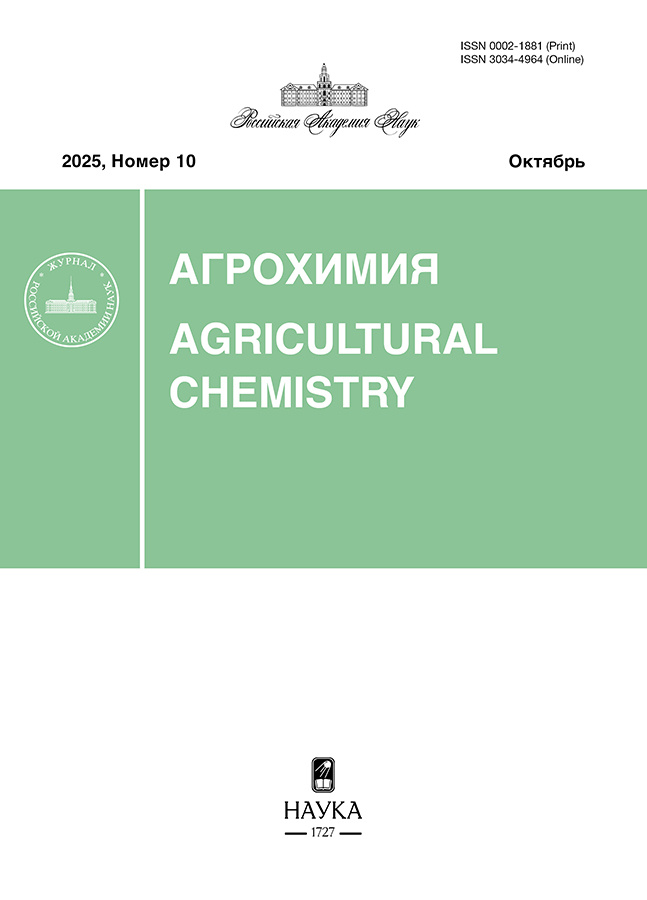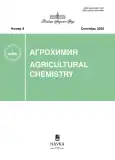УЛЬТРАДИСПЕРСНЫЕ И ИОННЫЕ ФОРМЫ СЕРЕБРА: ОЦЕНКА ВЛИЯНИЯ НА РОСТ ПРОРОСТКОВ ПШЕНИЦЫ Triticum aestivum И ПЕРСПЕКТИВЫ ИСПОЛЬЗОВАНИЯ В КАЧЕСТВЕ НОВЫХ СРЕДСТВ ЗАЩИТЫ РАСТЕНИЙ
- Авторы: Пешков С.А.1, Галактионова Л.В.1, Ховрина Т.Д.1, Пешкова Т.В.1, Муковоз П.П.2, Глинушкин А.П.3,4, Степанова Е.В.3, Юдин А.А.1, Сизенцов А.Н.1
-
Учреждения:
- Оренбургский государственный университет
- Чувашский государственный университет им. И.Н. Ульянова
- Институт органической химии им. Н.Д. Зелинского РАН
- Российский университет дружбы народов им. П. Лумумбы
- Выпуск: № 9 (2025)
- Страницы: 49-59
- Раздел: Пестициды
- URL: https://bakhtiniada.ru/0002-1881/article/view/318998
- DOI: https://doi.org/10.7868/S3034496425090067
- ID: 318998
Цитировать
Аннотация
Изучена возможность использования ультрадисперсных форм серебра как биоцидных компонентов пестицидов нового поколения. Проведено исследование влияния ультрадисперсных частиц серебра и его ионных форм на рост Triticum aestivum L. Оценку воздействия ионных форм производили на примере хелата – глицината и нитрата серебра. Ультрадисперсные частицы серебра получали методом «зеленого синтеза» путем взаимодействия нитрата серебра с кверцетином и добавления 5%-ного раствора аммиака. В работе методом динамического рассеяния света подтверждены размеры наноформ Ag. Показали, что малые количества ультрадисперсных частиц серебра не оказывали угнетающего влияния на всхожесть и биохимические параметры растений. Нитрат серебра в концентрации 8.493 × 10–4 г/л замедлял процессы роста и развития Triticum aestivum, а воздействие глицината серебра на витальные, морфометрические и биохимические параметры культуры коррелировало с его содержанием в растворе. Концентрация 8.427 × 10–3 г Ag+/л практически полностью подавляла всхожесть пшеницы, а при ее снижении до 1.053 × 10–3 г Ag+/л негативное влияние глицината ослабевало. Нитраты, хелаты и ультрадисперсные частицы Ag проявили выраженный фунгицидный и бактерицидный эффекты, что на фоне отсутствия фитотоксичности наноформы металла свидетельствовало о перспективности ее использования для предпосевной обработки семян. Низкая концентрация ультрадисперсных частиц в растворе с экономической стороны будет способствовать снижению стоимости конечной продукции.
Ключевые слова
Об авторах
С. А. Пешков
Оренбургский государственный университет
Email: mpp27@mail.ru
460018 Оренбург, просп. Победы, 13, Россия
Л. В. Галактионова
Оренбургский государственный университет
Email: mpp27@mail.ru
460018 Оренбург, просп. Победы, 13, Россия
Т. Д. Ховрина
Оренбургский государственный университет
Email: mpp27@mail.ru
460018 Оренбург, просп. Победы, 13, Россия
Т. В. Пешкова
Оренбургский государственный университет
Email: mpp27@mail.ru
460018 Оренбург, просп. Победы, 13, Россия
П. П. Муковоз
Чувашский государственный университет им. И.Н. Ульянова
Email: mpp27@mail.ru
428015 Чебоксары, Московский просп., 15, Россия
А. П. Глинушкин
Институт органической химии им. Н.Д. Зелинского РАН; Российский университет дружбы народов им. П. Лумумбы
Email: mpp27@mail.ru
119991 Москва, Ленинский просп., 47, Россия; 115419 Москва, ул. Орджоникидзе, 3, Россия
Е. В. Степанова
Институт органической химии им. Н.Д. Зелинского РАН
Email: mpp27@mail.ru
119991 Москва, Ленинский просп., 47, Россия
А. А. Юдин
Оренбургский государственный университет
Email: mpp27@mail.ru
460018 Оренбург, просп. Победы, 13, Россия
А. Н. Сизенцов
Оренбургский государственный университет
Автор, ответственный за переписку.
Email: mpp27@mail.ru
460018 Оренбург, просп. Победы, 13, Россия
Список литературы
- Han Y., Sun T., Tang Y., Yang M., Gao W., Wang L., Sui C. Root rot in medicinal plants: a review of extensive research progress // Front. Plant Sci. 2024. V. 15. P. 1504370.
- Abbas A., Mubeen M., Sohail M.A., Solanki M.K., Hussain B., Nosheen S., Kashyap B.K., Zhou L., Fang X. Root rot a silent alfalfa killer in China: Distribution, fungal, and oomycete pathogens, impact of climatic factors and its management // Front. Microbiol. 2022. V. 13. P. 961794.
- Yu F., Chen Y., Huang X., Shi J., Xu J., He Y. Does straw returning affect the root rot disease of crops in soil? A systematic review and meta-analysis // J. Environ. Manag. 2023. V. 336. P. 117673.
- Sawosz F., Pineda L., Hotowy A., Jaworski S., Prasek M., Sawosz E., Chwalibog A. Nano-nutrition of chicken embryos. The effect of silver nanoparticles and ATP on expression of chosen genes involved in myogenesis // Arch. Animal Nutr. 2013. V. 67. № 5. P. 347–355.
- Pineda L., Sawosz E., Lauridsen C., Engberg R.M., Elnif J., Hotowy A., Sawosz F., Chwalibog A. Influence of in ovo injection and subsequent provision of silver nanoparticles on growth performance, microbial profile, and immune status of broiler chickens // Animal Physiol. 2012. V. 4. P. 1–8.
- Wang C., Wang M.Q., Ye S.S., Tao W.J., Du Y.J. Effects of copper-loaded chitosan nanoparticles on growth and immunity in broilers // Poult. Sci. 2011. V. 90. № 10. P. 2223–2228.
- Shirsat S., Kadam A., Mane R.S., Jadhav V.V., Zate M.K., Naushad M., Kim K.H. Protective role of biogenic selenium nanoparticles in immunological and oxidative stress generated by enrofloxacin in broiler chicken // Dalton Transit. 2016. V. 45. № 21. P. 8845–8853.
- Miroshnikov S., Yausheva E., Sizova E., Miroshnikova E. Comparative assessment of effect of copper nano- and microparticles in chicken // Orient. J. Chem. 2015. V. 31. № 4. P. 2327–2336.
- Safa S., Moghaddam G., Jozani R.J., Daghigh Kia H., Janmohammadi H. Effect of vitamin E and selenium nanoparticles on post-thaw variables and oxidative status of rooster semen // Animal Reproduct. Sci. 2016. V. 174. P. 100–106.
- Kim H.J., Kim S.H., Lee J.K., Choi C.U., Lee H.S., Kang H.G., Cha S.H. A novel mycotoxin purification system using magnetic nanoparticles for the recovery of aflatoxin B1 and zearalenone from feed // J. Vet. Sci. 2012. V. 13. № 4. P. 363–369.
- Sawosz F., Pineda L.M., Hotowy A.M., Hyttel P., Sawosz E., Szmidt M., Niemiec T., Chwalibog A. Nano-nutrition of chicken embryos. The effect of silver nanoparticles and glutamine on molecular responses, and the morphology of pectoral muscle // Balt. J. Comparat. Clinic. Syst. Biol. 2012. V. 2. P. 29–45.
- Liu X., Theil E.C. Ferritin as an iron concentrator and chelator target // Ann. N.Y. Acad. Sci. 2005. V. 1054. № 1. P. 136–140.
- Parkinson S.J., Tungsirisurp S., Joshi C., Richmond B.L., Gifford M.L., Sikder A., Lynch I., O’Reilly R.K., Napier R.M. Polymer nanoparticles pass the plant interface // Nat. Сommun. 2022. V. 13. № 1. P. 7385.
- Husted S., Minutello F., Pinna A., Tougaard S.L., Mos P., Kopittke P.M. What is missing to advance foliar fertilization using nanotechnology? // Trend. Plant Sci. 2023. V. 28. № 1. P. 90–105.
- Siddiqui M.H., Al-Whaibi M.H., Firoz M., Al-Khaishany M.Y. Role of nanoparticles in plants // Nanotechnol. Plant Sci. Cham: Springer Inter. Publ., 2015. P. 19–35.
- Brusko V., Garifullin B., Geniyatullina G., Kuryntseva P., Galieva G., Galitskaya P., Selivanovskaya S., Dimiev A.M. Novel biodegradable chelating agents for micronutrient fertilization // J. Agricult. Food Chem. 2023. V. 71. № 41. P. 14979–14988.
- Hyder S., Ul-Nisa M., Shahzadi, Shahid H., Gohar F., Gondal A.S., Riaz N., Younas A., Santos-Villalobos S.L., Montoya-Martinez A.C., Sehar A., Latif F., Rizvi Z.F., Iqbal R. Recent trends and perspectives in the application of metal and metal oxide nanomaterials for sustainable agriculture // Plant Physiol. Biochem. 2023. V. 202. P. 107960.
- Laoue J., Fernandez C., Ormeno E. Plant flavonoids in mediterranean species: A Focus on flavonols as protective metabolites under climate stress // Plants. 2022. V. 11. № 2. P. 172.
- Vargova Z., Olejnikova P., Kuzderova G., Rendosova M., Havlickova J., Gyepes R., Vilkova M. Silver(I) complexes with amino acid and dipeptide ligands – Chemical and antimicrobial relevant comparison (mini review) // Bioorg. Chem. 2023. V. 141. P. 106907.
- Makarov V.V., Love A.J., Sinitsyna O.V., Makarova S.S., Yaminsky I.V., Taliansky M.E., Kalinina N.O. “Green” nanotechnologies: Synthesis of metal nanoparticles using plants // Acta Natur. 2014. V. 6. № 1. P. 35–44.
- Mustapha T., Misni N., Ithnin N.R., Daskum A.M., Unyah N.Z. A Review on plants and microorganisms mediated synthesis of silver nanoparticles, role of plants metabolites and applications // Inter. J. Environ. Res. Public Health. 2022. V. 19. № 2. P. 674.
- Wang X., Xin C., Cai J., Zhou Q., Dai T., Cao W., Jiang D. Heat priming induces trans-generational tolerance to high temperature stress in wheat // Front. Plant Sci. 2016. V. 7. P. 501.
- Gupta N., Upadhyaya C.P., Singh A., Abd-Elsalam K.A., Prasad R. Applications of silver nanoparticles in plant protection // Nanobiotechnology Applications in Plant Protection / Ed. Abd-Elsalam K.A., Prasad R. Cham: Springer International Publishing, 2018. P. 247–265.
- Dykman L.A., Shchyogolev S.Y. Interactions of plants with noble metal nanoparticles // Agricult. Biol. 2017. V. 52. № 1. P. 13–24.
- An J., Zhang M., Wang S., Tang J. Physical, chemical and microbiological changes in stored green asparagus spears as affected by coating of silver nanoparticles-PVP // LWT – Food Sci. Technol. 2008. V. 41. № 6. P. 1100–1107.
- Savithramma N., Ankanna S., Bhumi G. Effect of nanoparticles on seed germination and seedling growth of Boswellia ovalifoliolata an endemic and endangered medicinal tree taxon // Nano Vision. 2012. V. 2. № 1. P. 61–68.
- Омельченко А.В., Юркова И.Н., Жижина М.Н. Стимулирующее действие наночастиц серебра на рост и развитие растений пшеницы // Уч. зап. Крым. фед. ун-та им. В.И. Вернадского. Биология. Химия. 2014. Т. 27. № 1 (66). C. 127–135.
- Assessment of silver nanoparticles contamination on faba bean – Rhizobium leguminosarum bv. Viciae–Glomus aggregatum symbiosis: Implications for induction of autophagy process in root nodule // Agricult. Ecosyst. Environ. 2016. V. 218. P. 163–177.
- Song U., Jun H., Waldman B., Roh J., Kim Y., Yi J., Lee E.J. Functional analyses of nanoparticle toxicity: a comparative study of the effects of TiO2 and Ag on tomatoes (Lycopersicon esculentum) // Ecotoxicol. Environ. Saf. 2013. V. 93. P. 60–67.
- Zuverza-Mena N., Armendariz R., Peralta-Videa J.R., Gardea-Torresdey J.L. Effects of silver nanoparticles on radish sprouts: Root growth reduction and modifications in the nutritional value // Front. Plant Sci. 2016. V. 7. P. 90.
- Doolette C.L., McLaughlin M.J., Kirby J.K., Navarro D.A. Bioavailability of silver and silver sulfide nanoparticles to lettuce (Lactuca sativa): Effect of agricultural amendments on plant uptake // J. Hazard. Mater. 2015. V. 300. P. 788–795.
- Barrena R., Casals E., Colon J., Font X., Sanchez A., Puntes V. Evaluation of the ecotoxicity of model nanoparticles // Chemosphere. 2009. V. 75. № 7. P. 850–857.
- Galazzi R.M., Santos Ede B., Caurin T., Pessoa Gde S., Mazali I.O., Arruda M.A. The importance of evaluating the real metal concentration in nanoparticles post-synthesis for their applications: A case-study using silver nanoparticles // Talanta. 2016. V. 146. P. 795–800.
- Mirzajani F., Askari H., Hamzelou S., Farzaneh M., Ghassempour A. Effect of silver nanoparticles on Oryza sativa L. and its rhizosphere bacteria // Ecotoxicol. Environ. Saf. 2013. V. 88. P. 48–54.
- Gubbins E.J., Batty L.C., Lead J.R. Phytotoxicity of silver nanoparticles to Lemna minor L. // Environ. Pollut. 2011. V. 159. № 6. P. 1551–1559.
- Lee W.M., Kwak J.I., An Y.J. Effect of silver nanoparticles in crop plants Phaseolus radiatus and Sorghum bicolor: media effect on phytotoxicity // Chemosphere. 2012. V. 86. № 5. P. 491–499.
- Jiang H.S., Qiu X.N., Li G.B., Li W., Yin L.Y. Silver nanoparticles induced accumulation of reactive oxygen species and alteration of antioxidant systems in the aquatic plant Spirodela polyrhiza // Environ. Toxicol. Chem. 2014. V. 33. № 6. P. 1398–1405.
- Musante C., White J.C. Toxicity of silver and copper to Cucurbita pepo: differential effects of nano and bulk-size particles // Environ. Toxicol. 2012. V. 27. № 9. P. 510–517.
- Shabatina T.I., Vernaya O.I., Melnikov M.Y. Hybrid nanosystems of antibiotics with metal nanoparticles-novel antibacterial agents // Molecules. 2023. V. 28. № 4. P. 1603.
- Reda A.T., Park J.Y., Park Y.T. Zinc oxide-based nanomaterials for microbiostatic activities: A Review // J. Funct. Biomater. 2024. V. 15. № 4. P. 103.
- ПешковС.А., Галактионова Л.В., Ховрина Т.Д., Юдин А.А., Муковоз П.П., Пешкова Т.В., Глинушкин А.П. Влияние глицината железа и его ультрадисперсных частиц на ростовые и биохимические параметры проростков Triticum aestivum L. // Агрохимия. 2025. № 4. С. 40–48.
Дополнительные файлы










